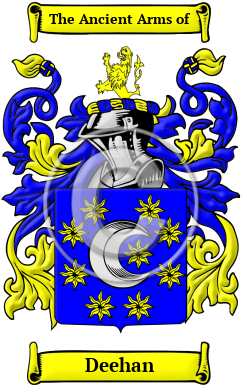| ![Show Contents]() Deehan History, Family Crest & Coats of Arms Deehan History, Family Crest & Coats of Arms
- Origins Available:
Ireland
Etymology of DeehanWhat does the name Deehan mean? The ancient Gaelic form of the Irish name Deehan was Ó Dubhaigan, Anglicized O'Dugan, Dugan, Duggan and Doogan. "Dubhagan means a 'dark featured small-sized man." 1 They are the hereditary Chiefs of Fermoy and descend directly from Fergus Mor (Fergus MacRoy), King of Ulster. 1 Early Origins of the Deehan familyThe surname Deehan was first found in County Clare (Irish: An Clár) located on the west coast of Ireland in the province of Munster, where O'DuilAgin, O'Dugan, (or O'Deegan), chief of Muintir ConIochta, a district in the parish of Tomgraney, in the barony of Tullagh. The family line is directly traceable to Fergus Mor (Fergus the Great). In turn his ancestry is associated with King Ir, brother of the equally famous Heremon. The name was first found near what is now the town of Fermoy, in the territory formerly known as Roche's Country. This territory encompassed the junction of the counties Cork, Tipperary and Waterford. In modern times, the surname is generally found in these three counties. However, there was another O'Dugan sept in the territory called Ui Maine, also called Hy Many, which spans eastern county Galway and southern county Roscommon. This sept gave their name to the place called Ballyduggan, near Loughrea. 2 Early History of the Deehan familyThis web page shows only a small excerpt of our Deehan research. Another 155 words (11 lines of text) covering the years 1327, 1813, 1823, 1884 and 1896 are included under the topic Early Deehan History in all our PDF Extended History products and printed products wherever possible. Deehan Spelling VariationsIn the days before Gaelic or English gained any significant semblance of standardization, the scribes who created documents simply recorded names as they sounded. Consequently, in the Middle Ages many people were recorded under different spellings each time their name was written down. Research into the Deehan family history revealed numerous spelling variations of the name, including Dugan, Duggan, O'Duggan, Dougan, Douggan, Dewgan, Deugan and many more. Early Notables of the Deehan familyAnother 29 words (2 lines of text) are included under the topic Early Deehan Notables in all our PDF Extended History products and printed products wherever possible.
| Deehan migration to the United States | + |
Ireland, as an English-controlled colony in the 19th century, suffered the loss of hundreds of thousands of its native people. The system of land ownership often did not sufficiently provide for the tenants who farmed the land. This was most clearly evidenced in the Great Potato Famine of the 1840s. Previous years of great demand for grain products and livestock had run the land down. Many landowners foreseeing an upcoming crisis often removed families from the land or forced them to rely on pitifully small plots where only a subsistence living could be made. When the famines of 1845, 46, and 48 hit, many had nothing. Disease and starvation became widespread and families boarded ships for elsewhere any way they could. Those who went to America were instrumental in developing the industrial power known today: many Irish were employed in hard labor positions in factories and in building the bridges, canals, roads, and railways necessary for a strong industrial nation. Research of early immigration and passenger lists has shown that many bearers of the name Deehan:
Deehan Settlers in United States in the 19th Century- Mary Deehan, aged 20, who arrived in New York, NY in 1833 3
- Michael Deehan, aged 30, who landed in New York, NY in 1833 3
- Neill Deehan, aged 24, who arrived in New York, NY in 1833 3
| Deehan migration to Australia | + |
Emigration to Australia followed the First Fleets of convicts, tradespeople and early settlers. Early immigrants include: Deehan Settlers in Australia in the 19th Century- Mrs. Esther Deehan, (Quigley), (b. 1798), aged 28, Irish house servant who was convicted in Londonderry, Ireland for 7 years for stealing, transported aboard the "Brothers" on 3rd October 1826, arriving in New South Wales, Australia 4
- Owen Deehan, who arrived in Adelaide, Australia aboard the ship "Delhi" in 1839 5
- Patrick Deehan, who arrived in Adelaide, Australia aboard the ship "Delhi" in 1839 5
| Contemporary Notables of the name Deehan (post 1700) | + |
- John Matthew Deehan (b. 1957), English footballer and manager from Solihull, England
- Geoff Deehan (b. 1952), British film and television producer, known for Curiosity (2011), Equinox (1986) and The Heist (2004)
- O'Hart, John, Irish Pedigrees 5th Edition in 2 Volumes. Baltimore: Genealogical Publishing Company, 1976. Print. (ISBN 0-8063-0737-4)
- MacLysaght, Edward, Irish Families Their Names, Arms and Origins 4th Edition. Dublin: Irish Academic, 1982. Print. (ISBN 0-7165-2364-7)
- Filby, P. William, Meyer, Mary K., Passenger and immigration lists index : a guide to published arrival records of about 500,000 passengers who came to the United States and Canada in the seventeenth, eighteenth, and nineteenth centuries. 1982-1985 Cumulated Supplements in Four Volumes Detroit, Mich. : Gale Research Co., 1985, Print (ISBN 0-8103-1795-8)
- Convict Records Voyages to Australia (Retrieved 3rd November 2020). Retrieved from https://convictrecords.com.au/ships/brothers
- State Records of South Australia. (Retrieved 2010, November 5) DELHI 1839. Retrieved from http://www.slsa.sa.gov.au/BSA/1839Delhi.htm
 |

